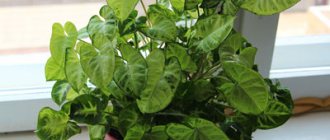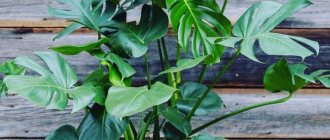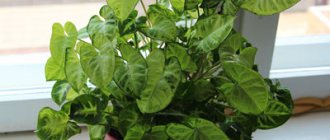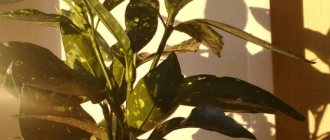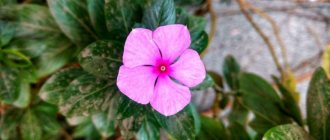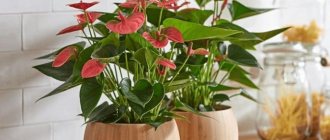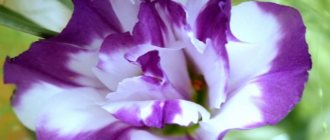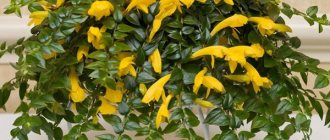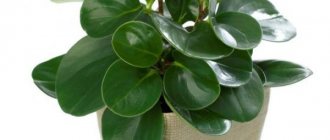Syngonium is an unpretentious and very elegant climbing plant. It is believed that syngonium has a positive effect on mental abilities and reveals talents. It is often given to cultural and scientific figures. Syngonium also becomes a talisman for shy people who want to overcome their fears and complexes. Liana creates a positive mood and inspires optimism. And with minimal care, the syngonium will live a long life and become part of the legacy of its grandchildren.
What does syngonium look like and where does it come from?
Syngonium is a plant from the Araceae family, which is found in the humid tropics of America, in particular Brazil, Guatemala, Panama and Mexico. This is a very spectacular flower, growing in nature both as a liana and as an epiphyte, entwining trees and forming numerous aerial roots.
Syngonim leaves look like arrowheads
A special feature of this tropical vine is the unusual shape of its leaf blades, which look like arrowheads. In addition, the plant is capable of changing its color with age.
Under natural conditions, the plant blooms very unusually. Its flowers form an inflorescence in the form of a spadix with a white-pink veil. However, it will not be possible to see this “in captivity”, even if the syngonium is provided with all the necessary conditions and proper care.
Young syngoniums have a bright light green color and solid leaf blades; over time they become darker and dissected into several lobes. A characteristic feature is a thick vein located parallel to the edge of the leaf blade.
Unfortunately, syngonium does not bloom at home
Growing syngonium at home is not difficult. The flower does not require excessive care. By following just a few rules, you can get a magnificent and large plant.
Important! Syngonium is poisonous, like all plants of the Araceae family. Its milky juice can lead to irritation of the mucous membranes.
Types and varieties
Botanists identify about 30 species of syngonium that grow in natural conditions. Only a few of them are used as houseplants, but breeders have developed magnificent varieties that are impressive with their extraordinary foliage color.
- Syngonim eared is found in nature in Haiti, Jamaica and Mexico, and grows in both the tropics and mountainous areas. The shoots of this vine are quite thick (about 2 cm in girth). The leaves are glossy, bright green in color, and their shape changes over time and different leaf blades can be observed on the same vine.
- The Wendland Syngonium is native to Costa Rica. This is a vine with a green stem. A distinctive feature of this species is that the surface of the leaf blades is velvety to the touch. The leaves of adult specimens are divided into three segments.
- Syngonium legifolia (podophylfolia) is a representative of the flora of Honduras, Guatemala, Panama, Costa Rica and Mexico. Its dark green leaves are also shaped like an arrowhead when young. Over time, they become dissected into 5–11 parts. This plant is most often grown indoors.
Several spectacular hybrids and varieties have been bred based on Syngonium aurica:
- Syngonium variety Emerald Gem has fleshy dark green leaf blades;
- plant of the Emerald Gem Variegated variety is a small compact bush with thin leaves covered with spots of white and light gray;
- the flower variety called Imperial White has almost completely white leaf blades;
- The syngonium of the Green Gold variety is very beautiful, the leaf blades of which are painted dark green and have light green veins.
Species diversity of syngonium in the photo
The synonym eared is found in nature in Haiti, Jamaica and Mexico
Syngonium Wendland is native to Costa Rica.
Syngonium legifolia (podophylleaf) - representative of the flora of Honduras, Guatemala, Panama, Costa Rica and Mexico
A spectacular Emerald Gem vine with fleshy dark green leaves
The leaves of this Emerald Gem Variegated variety have an unusual color.
The peculiarity of the variety is light green veins on the leaves.
Description of the syngonium plant
Syngonium is an evergreen, perennial plant, a semi-epiphyte from the Araceae family. The Latin name combines two words: “syn” and “gone”, and perfectly reveals the characteristics of this plant, because it is literally translated as “ovule”.
Thus, the name of the plant describes the life cycle of the vine: the plant transforms pollinated seed embryos capable of germination into ovaries and reliably hides them in flower petals. And from the outside it seems that large buds have swelled on the vine.
Syngoniums grow in the tropical forests of South America. In nature there are twenty species.
It is not possible to give a general description of this plant. Each species has a different foliage shape, color, size and ability to change over the years.
In addition, a feature of syngonium is the ability to throw out leaves of different shapes on one shoot: in the shape of a peak, a heart, and even a thin arrow, and the color of the foliage and its texture can also be combined.
All types of syngonium have one thing in common: a bright vein in the center of the leaf from the base to the top.
Syngonium can bloom only in the wild. The flowers ripen into fruits containing about a hundred seeds. The fruits themselves are edible. They are eaten by both people and animals.
The juice of the stems, leaves and roots of syngonium is toxic and can cause allergic reactions and skin burns.
Table: conditions necessary for syngonium
| Humidity | Temperature | Light | |
| Spring Summer | Syngonium prefers high air humidity. In summer, it is recommended to frequently spray the flower with warm water, and wipe the leaf blades with a damp cloth or sponge to prevent the appearance of pests. | The most comfortable temperature is +18–24 °C. | The plant is shade-tolerant and does not like direct sunlight; syngonium needs soft, diffused lighting. The best option for placing the flower would be an east-oriented window. It can also be placed inside the room, placed on a shelf or table. |
| Autumn winter | There is no need to spray the syngonium. It is enough to place it in a tray with wet expanded clay or peat if the flower is located near a heating radiator. | The temperature of the syngonium should be at least +17–18 °C, however, the plant can tolerate a short-term drop of up to 10 °C, but you should not expose the flower to hypothermia for too long. | Additional lighting is required in the morning and evening hours so that the shoots do not stretch too much and become brittle and brittle. |
Table: maintenance features depending on the season
| Season | Temperature | Humidity | Watering | Lighting | Top dressing |
| Spring Summer | +18°С -+24°С | Daily spraying. Once a month, take a warm shower. | Apply liberally as the substrate dries. | Semi-shaded places, diffused light. | Every 2–3 weeks. |
| Autumn winter | +15°С -+18°С | Spraying 2-3 times a week. | In autumn - rarely, in winter - very rarely. | Scattered light. For variegated species, sometimes artificial lighting | Not required. |
Plant care
Location
Syngoniums do not like intense lighting. In bright light, plant leaves turn pale, lose turgor and wither. Windows with an eastern orientation are best suited for them; they can also grow well inside a room, away from a light source.
Syngoniums should not be placed near light sources
Watering mode
Syngonium is a “water drinker”; it requires abundant watering throughout the year. In this case, you need to ensure that water does not stagnate in the pan (excessive dampness can lead to rotting of the roots).
After each watering, drain excess moisture from the pan.
In winter, watering is required abundantly, but not very often; moisten the plant a day after the top layer of soil has dried (about once a week).
Fertilizer application
The liana responds to feeding with excellent growth and bright, juicy foliage. Fertilizers should begin to be applied two months after planting. Until this time, the syngonium has enough nutrients, which it receives from fresh substrate.
Any complex fertilizer is suitable for feeding syngonium.
Fertilize the syngonium in spring and summer twice a month with a solution of special mineral fertilizer. Any preparation for decorative foliage plants is suitable (it is especially convenient to use liquid forms). With the onset of autumn, stop fertilizing completely.
Shaping and trimming
The syngonium can be formed in the form of a neat bush, an ampelous plant, or the vine can be allowed to grow upward, wrapping itself around a support.
How to form a lush bush
To form a lush bush, the flower must be periodically pinched above the fifth or sixth leaf. They do this year-round, as soon as the shoot begins to grow.
Despite the fact that syngonium is a vine, it can be grown in the form of a bush
Ampelous plant in your home
When forming a syngonium in the form of an ampelous plant, it is not necessary to pinch the shoots; they are allowed to grow to the desired size. A flower of this shape looks great in hanging baskets and plant pots.
The ampelous shape is natural for syngonium
Plant entwining a support
The syngoniums entwining the support are very decorative. This can be any wooden cutting, wrapped in moss or coconut fiber.
Syngoniums entwining the support are very decorative
The support should be installed in the container during transplantation. For this:
- Place drainage and soil at the bottom of the container and stick a stick into it.
- Position the plants by spreading the roots around the support.
- Fill the voids with substrate and compact it.
The vine shoots will curl along such a support, resulting in a spectacular plant reaching two meters in height.
Video: syngonium care
Can I keep it at home?
Syngonium, as mystics say, is useful for introverts and indecisive and shy people to grow at home . Liana awakens activity in them, allows them to master the art of oratory, overcome groundless fears and cope with complexes.
The energy of the flower allows older people to get rid of conservatism, and students - to better assimilate new knowledge and adapt to a new environment.
The only thing: do not place a flower in the children's room so that the child does not have the desire to play with it.
Possible care errors: why they appear and how they can be corrected
| Problem | Possible reason | Bug fix |
| The leaves acquire a yellow tint, unusual for the variety, become small, and the variegated pattern on the surface disappears. | There are not enough nutrients or the plant is too crowded in the pot. |
|
| The tips of the leaves turn yellow and then turn brown, the leaf blades curl and fall off. | Too dry air in the room, insufficient watering. |
|
| The color of the leaves becomes pale. | Insufficient lighting or excessive watering. |
|
| Droplets of moisture appear at the tips of the leaf blades. | This is the usual state of syngonium, so the plant removes excess water. | There is no need to specifically reduce humidity; you can limit the number of sprays. |
| Leaf petioles and shoots become smaller and turn black. | Root rot due to overwatering. |
|
| The stems stretch and become thin. | The plant does not have enough light. | Move it to another place, and illuminate it with a fluorescent lamp in winter. |
Why do syngonium leaves turn yellow?
If the leaves of a plant turn yellow during growth, this is most often due to a lack of beneficial microelements. To correct the situation, you need to buy high-quality fertilizer for the syngonium at any flower shop. However, you need to water the flower with the chosen product in moderation, because the plant will also suffer from an overabundance of the drug. Then you need to regularly fertilize the syngonium to prevent repeated yellowing of the leaves.
Table: diseases and pests of syngonium
| Name of pest or disease | Signs | Treatment | Prevention measures |
| Root rot | At the base, the leaf blades turn black, the same happens with the petioles, they are easily separated from the shoot. The stem becomes limp and turns black. | Replant the plant in fresh soil. When replanting, cut off all rotten roots, shoots and leaves and treat them with a solution of any fungicide. |
|
| Shield aphid (scale insect) | Brown plaques appear on the leaf blades, then the leaves dry out and fall off. | Wash them off with a cotton swab dipped in an alcohol solution. Treatment with a soap solution containing tobacco dust also helps. Such procedures should be carried out several times, but they do not guarantee complete disposal of the scale insect; after a while the insect may appear again. If this happens, spray the syngonium with Actellik. If necessary, carry out another treatment after a week. | Periodically humidify the air around the plant and check neighboring flowers for scale infestation. |
| Mealybug | The top of the leaves becomes deformed and changes color. Whitish flakes appear on the surface of leaf blades and soil. | Wipe the leaves with a cotton swab dipped in ethyl alcohol. Spray the syngonium with Aktara or Actellik. A total of three procedures will be required at an interval of two weeks. |
|
| Trips | Yellow spots appear on the leaf blades of syngonium, sometimes in the form of streaks. Leaves die and fall off. | The only way to get rid of thrips is with insecticides. Treat the plant with Fitoverm, Vermitek or Actellik. Carry out at least two treatments a week apart. | Do not allow the soil to dry out, moisten the air around the plant. |
Syngonium pests in the photo
When scale insects appear, immediately wash the plant with soapy water.
You can get rid of thrips only with the help of insecticides
If mealybugs appear, treat the plant with insecticides.
Signs and superstitions
There are many beliefs regarding this plant. And they are not only positive. For example, some believe that syngonium drives men out of the house (which, however, in practice turns out to be a fiction). According to the teachings of Feng Shui, the liana has “poisonous breath” - i.e. releases a toxic substance from the leaves, which has a bad effect on the owner’s nervous system. However, the sages do not advise throwing away the flower - just make and hang a protective amulet next to the plant.
Features of reproduction
It is very easy to propagate the vine. This is done through apical cuttings or pieces of a stem with a bud, as well as aerial roots. The procedure is simple, so even a novice florist can handle it.
Reproduction by shoot division - step-by-step description
- Divide the stem into several parts. Each of them must have at least one kidney. It is very good if there are aerial roots on the shoot, so rooting will take place much faster. Make the bottom cut at an angle (just below the bud or aerial roots), and the top cut straight.
- Plant the prepared cuttings in a substrate of peat, sand, turf and leaf soil (all ingredients in equal quantities).
- Moisten the plantings and cover them with a transparent plastic bag.
- Place the box with the cuttings in a warm place.
- Ventilate the greenhouse and water it daily.
- Under these conditions, roots will appear within a week.
- After 14 days, place the new specimens in separate containers.
This method allows you to obtain a large number of young specimens
Propagation by apical cuttings - step-by-step description
- Cut off the apical cutting with two or three leaves.
- Powder the cut with crushed activated carbon.
- Place the prepared cuttings in water. It takes root very quickly. After 2-3 days, small roots will appear, and after two weeks it can be planted in a small container. The substrate required for planting a rooted cutting is the same as for an adult plant.
Syngonium cuttings quickly take root in water
Reproduction of syngonium - video
Home care
To successfully grow syngonium at home, it is important to follow certain rules.
Lighting
Syngonium does not tolerate bright sunlight; it feels comfortable in oppressed places that receive a sufficient amount of diffused sunlight.
Watering, humidity and fertilization
Water the plant with settled water. In summer, watering is carried out abundantly as the substrate dries. With the arrival of cold weather, the amount of watering is significantly reduced to prevent rotting of the root system.
Syngonium prefers high air humidity. Daily spraying is required, as well as periodic wiping of the leaf plate. In summer, it is advisable to give the plant a monthly shower.
All varieties of Syngonium require regular application of mineral fertilizers, once every 2–3 weeks during the active growing season. It is important that the composition contains a minimum calcium content and a sufficient amount of nitrogen. You can use complex fertilizers for decorative deciduous houseplants, for example, Bona Forte or Blooming Paradise. Use them in accordance with the instructions. With the arrival of autumn and until the end of the dormant period, the plant does not need additional nutrition.
How to prune and form a beautiful plant?
To create a spectacular decorative look and better branching of the plant, it is necessary to use some techniques:
- The plant is pruned annually in the spring. Excessively long shoots are shortened to approximately 15–30 centimeters.
- To improve branching and add splendor, pinching the top of the syngonium above the sixth or seventh leaf is carried out.
- To make the plant look more beautiful, you should provide it with support, for example, install a moss tube in the center of the pot.
Table: problems during cultivation
| Signs | Possible reason | Solution |
| Leaves become smaller and growth slows down | Nutrient deficiencies | Perform regular feeding or transplant the plant into new soil |
| The tips dry, and then the leaf blade itself | Dry air | Increase the number of sprays, remove from heating devices |
| Leaves turn yellow | Excessive watering or bright lighting | Adjust the watering regime, shade from bright light or rearrange |
| Withering of foliage due to rotting of the root system | Overwatering | Adjust mode |
| Elongation of shoots | Lack of light | Provide sufficient sunlight |
Reviews from flower growers
Many people grow this plant, love it, but do not know that its scientific name is Syngonium. The plant is native to the tropics. Syngonium is a hanging plant that grows like a liana. It reproduces easily - the plant forms aerial roots, which, once in moist soil, germinate and the branch takes root. Syngonium loves moisture and frequent spraying of leaves. Cannot tolerate excessive heat or cold. Attention: the flower is poisonous and it is advisable to place it away from children and animals.
olga-koshka2
https://irecommend.ru/content/etot-tsvetok-ozhivit-lyuboi-interer-pridast-estetiki-prekrasen-pravda-yadovit-foto-2-ukh-sin
Syngoniums are a very unpretentious and elegant decorative foliage plant. During the period of my great passion for plants, I learned that they are not only green and white-green, but also reddish and pink, and I decided that I urgently needed these varieties. I like syngoniums because they can be used to form a beautiful vine on a stick or on a wall or stand. Or a beautiful bush if you trim it in time. In addition, there are varieties that tend to be more bushy than liana-like, which is good news, since I like bushes more. What is required to care for syngonium? Almost nothing. So: 1. You need to plant in universal soil, be sure to put expanded clay or some other drainage on the bottom. Humus can be added to the soil.2. The size of the pot should not be too large, so it is very convenient to hang the flower in a flowerpot. Somewhere around 1.5 l.3. Water regularly as it dries. The plant cannot be dried, as it loses its decorative effect and the tips of the leaves begin to dry out or even die off.4. You can fertilize, if desired, with fertilizer for decorative foliage plants or natural fertilizers, if that’s what you do. On average, I water all decorative foliage plants with mineral water once every two weeks.5. Lighting. Not a south window, the bright sun can burn the leaves. But even in the dark, the plant will not be as strong, colored varieties may lose some of their color, and the leaves will become smaller. The result is moderate lighting on the western and eastern windows, possibly on the northern ones.6. It is advisable to frequently spray and wash the leaves in the shower.7. Rooting. Segments with aerial roots or root division. Propagates very easily.8. It does not tolerate heat - it can wither and turn yellow, the same goes for cold weather. ATTENTION! Syngonium is poisonous. The juice of the plant should not get on the mucous membranes or into the oral cavity. Therefore, it is advisable to keep the plant away from cats and children.
LvIcO4ka
https://irecommend.ru/content/lyubimoe-rastenie-kustovye-i-ampelnye-sorta-mnogo-foto
My syngonium appeared at home as a small piece of stem with a leaf. I placed it in water, then planted it in sand, it took root, in principle, this plant has a survival rate of 80–90%, out of 20 cuttings, 17 subsequently took root. Among syngoniums there are creeping and climbing species. It is this plant that I curl onto a support and it feels great.
polina-polina
https://otzovik.com/review_169424.html
I took the sprout of this plant from my mother; it was one leaf, almost without roots. Having planted the baby in the ground at home, I didn’t expect much, since flowers rarely took root after moving, but this one agreed to live with me and grew stronger before my eyes every month. Syngonium likes diffused light, abundant watering, and it likes moisture, but without excess. I assigned it a place in the bathroom, it’s always humid there, and I don’t forget to water it. They write that the older the Syngonium, the larger the stems and leaves should be, but my flower somehow decided to grow as a bush for now, maybe, of course, at an older age he will want more, but for now, so will I, and, apparently, everything suits him! There are several varieties of this flower, but mine, apparently, is the “White Butterfly” variety, as I learned from the Internet in comparison. So I recommend this bush to flower lovers, especially since it not only decorates the room, but also, as experts write, purifies the air in it!
Astro4Ka
https://otzovik.com/review_1778853.html
I wanted this flower for a long time, and finally one day I bought it. I bought it very small - only two leaves. The leaves reminded me of the shape of hearts. I would never have thought that this plant, one might say, requires no care at all, well, apart from, of course, watering. Syngonium loves where there is light, but not much, and non-sunlight, so I put it in the bedroom. If there is a lot of light, the leaves will be dull and pale. I sprayed it with water every day. After about two weeks, the number of leaves began to increase, when there were already 20 leaves, I decided to replant the plant. The roots of the syngonium were very long, I cut them off, left the youngest ones and planted them in a larger pot than it was. Two months passed and the plant began to curl. Now I already have three large pots with this beautiful flower, because they reproduce very easily. The other day I bought another plant like this, only in a different color.
whiting
https://otzovik.com/review_550663.html
Flowering and fruiting
Unfortunately, you can see how this tropical vine blooms only in its natural habitats. This happens at the end of spring, in May. The syngonium flower is a light cream-colored spadix, half hidden, as if in a niche, by a wide blanket, painted red or pink. The nature of pollination is cross. In place of the cob, a large juicy fruit gradually ripens, having a cylindrical or ovoid shape and a strong aroma that attracts monkeys. Inside there are up to hundreds of seeds, which are spread over long distances thanks to the animals that feed on these fruits.
Toxicity Being a typical representative of the Araceae family, the vine contains toxic milky sap, which can cause skin irritation, eczema, allergies, and if ingested, swelling of the larynx and problems with housing and communal services. It is found in all parts of the plant, in secretory cells, laticifers, etc. The poisonous juice protects the plant from being eaten by animals; it causes swelling of the mucous membranes. The juice contains enzymes, proteins, and aggressive oxalic acid. It is very dangerous if it gets into the eyes, the consequences develop in the form of conjunctivitis, and in severe cases, irreversible changes in the cornea can begin.
When working with a flower, you should always wear gloves, protecting your eyes from accidental splashes, and when placing the flowerpot in an apartment, place it in places inaccessible to children and pets.
Useful properties of syngonium
Syngonium has a positive effect on the atmosphere in the room. It is believed that this plant brings in the “spirit of the times” and helps to distract from everything old, looking to the future. Planting such a plant in the house is recommended for those who often look back to the past and do not want to accept modern reality.
Syngonium is capable of delivering powerful energy, relieving depression and passivity, and has a positive effect on mood and performance. It is useful to place a vine in the bedroom if you are tormented by bad dreams.
Types of home syngonium with photos and names
Syngonium podophyllum
The plant can have either light green or variegated heart-shaped leaves. The fused segments of each leaf create a large lobe with a length of 7 cm to 13 cm. It does not form inflorescences.
Syngonium Albolineatum
A hybrid species with brightly colored veins. White veins adorn the leaves and contrast clearly with the background.
Syngonium White Butterfly
A spectacular plant with rare, almost completely white leaves. Requires good lighting.
Syngonium Intra Red
The young leaves of this hybrid are pinkish in color. As it grows, green pigment is added, but the pink pattern remains.
Syngonium Spear Point
A popular species, often used as a hydroponic culture. The leaves are distinguished by contrasting white stripes that run parallel to each vein. The leaves are arrow-shaped, narrower than those of other species.
Syngonium auritum
The leaves of this species are arrow-shaped with two “ears”. The leaves of an adult plant have 3-5 segments and more pronounced spots in variegated syngoniums. The branches of the vine are long and can grow up to a meter in a year.
general information
Syngonium is a compact African liana, the shoots of which are densely covered with beautiful variegated leaves. Moreover, depending on the type, they can be solid, dissected or lobed. The branches are covered with aerial roots, so that the syngonium clings to any suitable support.
Interestingly, with age, the shape and shade of syngonium leaves can change. There are plain, spotted, striped and variegated species, as well as species with silver streaks. The color range varies from milky to dark green. Leaf sizes reach 35 cm.
There is a belief that if someone is sick in the house, syngonium contributes to his speedy recovery. According to another legend, it helps fight insomnia.
Photo: stocvetov.ru

